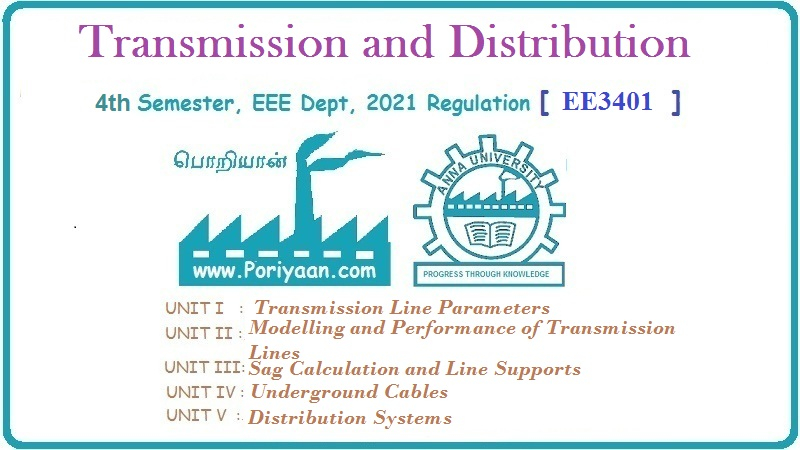Transmission and Distribution: Unit I: Transmission Line Parameters
Types of Line Conductors
Hard Drawn Copper - Steel Cored - Cadmium - All Aluminium Alloy - Phosphor Bronze
When the conductors are used in transmission system for bulk power transfer, then they should fulfill following requirements. 1. They should have low weight. 2. They should have high tensile and fatigue strength. 3. They must have high conductivity. 4. They should have low co-efficient of expansion, low corona loss. 5. They should have less resistance and low cost.
Types of Line Conductors
When the conductors are used in
transmission system for bulk power transfer, then they should fulfill following
requirements.
1. They should have low weight.
2. They should have high tensile and
fatigue strength.
3. They must have high conductivity.
4. They should have low co-efficient of
expansion, low corona loss.
5. They should have less resistance and
low cost.
Thus based on conductivity, tensile
strength, fatigue strength, corona loss, local conditions and cost, conductors
are selected for a particular line. The conductors used in practice are made up
from the materials such as copper, aluminium and their alloys.
The advantages of using aluminium
conductors over copper conductors are given below.
1. They have low cost.
2. Less resistance and corona loss.
3. Less weight.
But aluminium has less tensile strength,
high co-efficient of expansion and large area which restricts its use alone as
a conductor.
In order to increase the tensile
strength of a conductor, one or more central conductors of different materials
are used. These materials give high tensile strength. The different types of
aluminium conductors used in power systems with full forms of their abbreviations
are as given below.
AAC : - All aluminium conductor.
AAAC : - All aluminium alloy conductor.
ACSR : - Aluminium conductor with steel
reinforcement.
ACAR : - Aluminium conductor with alloy
reinforcement.
Normally the conductors are stranded as
it possess greater flexibility and mechanical strength as compared to single
wires of same cross sectional area. In stranded conductors, a central wire is
surrounded by successive layers of wires containing 6, 12, 18, 24 ... wires.
The consecutive layers are spiralled in opposite directions so as to avoid
unwinding. This also makes outer radius of one layer coincide with inner radius
of the next.
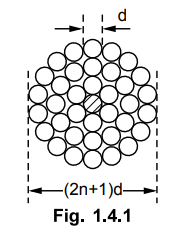
The stranded conductors are electrically
in parallel and spiralled together. Due to use of stranded conductors the skin
effect is reduced.
The conductor size is decided based on
its current carrying ability and voltage level on which it is working. The
total number of conductors in a strand of n layers are given by
Total number of conductors = 1 + 3n2 (1 + n) =
3n2 + 3n + 1
Overall diameter of stranded conductor with n layer D = (1
+ 2n) d
Here d is diameter of each strand. 7
strand conductor will have one central strand with 6 outer strands. While 19
strand conductor has a central strand and two layers of 6 and 12 strands each.
The size of conductor is specified by its equivalent copper cross sectional
area and the number of strands with the diameter of each strand.
Now we will discuss in brief the
commonly used conductors such as hard drawn copper, hard drawn aluminium and
steel cored aluminium conductors. The other materials are also used for making
conductors.
1. Hard Drawn Copper Conductor
The hard drawn copper conductors are
used for overhead lines which provides high tensile strength. These conductors
have relatively higher conductivity, long life and high scrap value. The copper
conductors are used for distribution network where length of line is short and
there are more tappings.
2. Steel Cored Copper
Conductor (SCC)
The steel cored copper conductors are
made by surrounding a steel core with one or more layers of copper strands. Due
to addition of steel core tensile strength of conductor is increased.
3. Cadmium Copper Conductor
With addition of cadmium there is
increase in the tensile strength of copper at the cost of decrease in the
conductivity. Thus these conductors can be used for longer spans. As tensile
strength is increased, longer spans with same sag is possible. The other
advantages include easiness in jointing, more resistance to atmospheric
corrosion, better resistance to wear and easy machinability. These conductors
are carried by smaller supports and are subjected to low wind and ice loadings
due to their smaller diameter.
4. Copper Weld Conductor
In this type of conductor, copper is
welded on to a steel wire by hot rolling and cold drawing a billet of steel
coated with copper. The uniform thickness of copper is welded. The conductivity
of this conductor lies in the range of 30 to 60 % of that of solid copper
conductor having same diameter. These are used for longer spans such as river
crossings.
5. All Aluminium Conductor
(AAC)
Due to increasing cost of copper,
aluminium is used in transmission system. Electrolytically refined aluminium is
rolled and drawn hard for use as conductor. For a specific resistance, cross
sectional area of aluminium conductor is greater than that of copper while its
weight is about 50 % of that of copper conductor. This makes transportation and
erection of such conductors economical. Corona effect is reduced due to
increased diameter of conductor. These conductors are more used in distribution
where transmission lines are short and voltage are lower. There are chances of
inter phase faults due to swing if these conductors are employed in the areas
where there are high winds. This is because aluminium conductors are lighter,
with large conductor area and more sag.
6. Aluminium Conductor with Steel Reinforcement (ACSR)
The mechanical strength that is obtained
from conductors made up from all aluminium. This difficulty can be overcome by
adding steel core to the conductor. The cross section of this conductor is as
shown in the Fig. 1.4.2 (a).
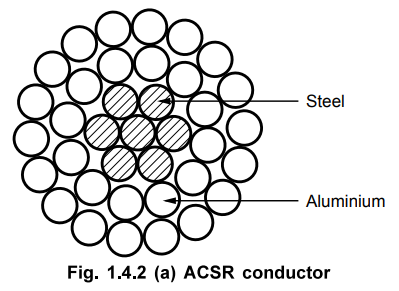
As shown in the Fig. 1.4.2 (a) there are
7 steel strands which forms central core. This is surrounded by two layers of
around 30 aluminium strands. For a given resistance conductors of different
strengths can be made by taking different properties of steel and aluminium
areas. The steel core does not contribute to conduction of current practically.
The current carrying capacity and resistance of this conductor is dependent on
conductivity of aluminium.
The ACSR conductors are more commonly
used as they have following advantages.
1. Due to high mechanical strength and
tensile strength, the line span can be increased. The sag is small. So shorter
supports are required for line. It is also possible to have longer spans for a
given sag. Due to smaller supports, breakdown possibility is low. Insulator and
other fittings needed are also less.
2. They have low corona loss.
3. Skin effect is less.
4. These conductors are inexpensive as
compared to copper conductors having equal resistance without reduction in
efficiency, useful life span and durability.
The disadvantage with ACSR conductor is
difficult to make splices and dead ends. There is also possibility of corrosion
due to electrochemical action between aluminium and steel core. The service
conditions decide corrosion rate. This is higher in industrial and coastal
areas.
The compacted ACSR conductor or smooth
body ACSR conductor is made by pressing conventional ACSR conductor through dies
to flatten the aluminium strands into segmental shape. The spaces within the strands
are filled while diameter of conductor is reduced. This does not affect
electrical and mechanical properties of this conductor. Thus with same
aluminium area, diameter of steel core is increased which increases mechanical strength. These conductors can be used for larger
span lengths. This is shown in the Fig. 1.4.3
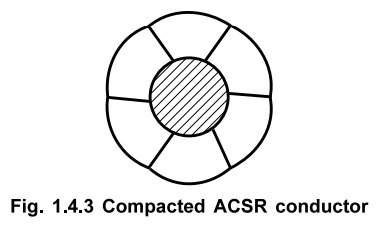
The expanded conductors are made by
adding a plastic or fibrous material between steel core and aluminium strands.
This increases diameter of conductor which reduces extra high voltages. This
type of conductor is shown in the Fig. 1.4.4
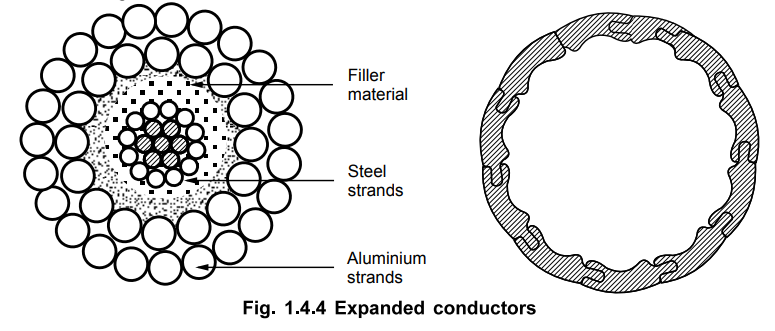
The filler material such as paper
separates the inner steel strands from outer aluminium strands.
7. All Aluminium Alloy
Conductor (AAAC)
The conductors made from aluminium
alloys are suitable in urban areas as they provide better tensile strength and
conductivity. These alloys are known with different names in various countries.
Some of these alloys are costly as they are heat treated. One of the alloys of
aluminium is known as silmalec which contains 0.5 % of silicon, 0.5 % of
magnesium and rest of aluminium. Due to this there is improvement in
conductivity and mechanical strength.
8. ACSR Conductor
In such conductor, the central core is
made up from aluminium alloy which is surrounded by layers of aluminium
conductors. The conductivity is better and strength to weight ratio is equal to
ACSR conductor having same diameter. As compared to ACSR conductor, ACAR
conductor is smaller in size and lower in weight for the same electrical
capacity.
9. Phosphor Bronze
Conductor
This type of conductor is strong than
copper conductor and may be used for longer line spans. The conductivity of
such conductor is low which can be improved by use of cadmium-copper core.
Phosphor bronze is found to be suitable for atmospheres containing harmful
gases.
10. Alumoweld Conductor
In this type of conductor, aluminium is
welded on a high strength steel wire. This is costlier as compared to steel
cored aluminium (SCA) or ACSR conductor. Around 75 % conductor area is covered
by aluminium. This is used in earth wires.
11. Galvanized Steel
Conductors
This type of conductor is suitable for
large length of line span or in rural areas where load requirement is
comparatively smaller. This type of conductor has high strength. The conductor
has large resistance, inductance and voltage drop. The disadvantage with this
conductor is it has shorter life.
12. Thermal Resistant
Aluminium Alloy Conductor (TACSR)
This conductor is similar in
construction to ACSR conductor. The change is that EC grade aluminium wires are
replaced by hard drawn aluminium wires of heat resistant aluminium alloy known
as TAL. These wires are doped with zirconium which makes these conductors well
suited for high temperatures. The various features of thermal resistant
aluminium alloy conductor are,
1. Very high current carrying capacity.
2. Good mechanical and electrical
properties at elevated temperatures.
3. Very stable at high temperatures.
4. Cost effective design.
5. Suited for raising the existing line
capacity.
13. Super Thermal Resistant Aluminium Alloy Conductor Invar Reinforced (STACIR or ZTAI)
Super thermal alloy is manufactured from
aluminium - zirconium (A1 - Zr) alloy rods. The arrangement is shown in the
Fig. 1.4.5. The outer layers are made up of super thermal resistant aluminium
alloy wires.
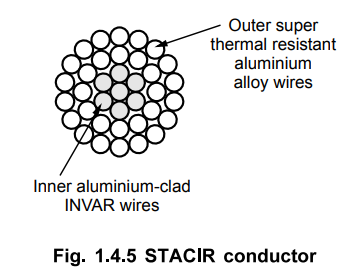
These are concentrically arranged over
inner core of aluminium clad INVAR (36 % Ni in steel). The current capacity of
this conductor is twice that of light aluminium conductor. The load capacity of
system can be increased simply by replacing existing conductors by STACIR
conductors without changing the steel towers. Thus it is very cost effective
and stable at high temperatures.
14. Gap Type Thermal
Resistant Aluminium Alloy Conductor Steel Reinforced (GTACSR)
It has a unique construction having a
small gap between the steel core and super thermal resistant aluminium alloy
layer.
The Fig. 1.4.6 shows the construction of
GTACSR. The central core is made up of extra high strength steel core. The
conductor part arranged around the core is made up of thermal resistant
aluminium alloy. There is a gap between inner layer of aluminium alloy and the
steel core which is filled with grease to avoid the friction. The inner layer
of aluminium alloy is trapezoidal in shape to maintain the gap.
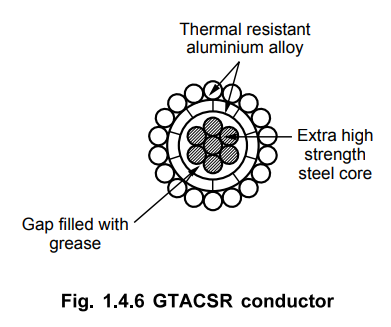
This conductor offers excellent sag and
current carrying characteristics. It can carry 1.6 times higher current than
ACSR conductor of same size. Its cost is low and construction period is short.
To increase the existing capacity, the existing conductors can be simply
replaced by GTACSR conductors without changing the towers. This construction
allows low sag properties and good mechanical strength
15. Gap Type Super Thermal
Resistant Aluminium Alloy Conductor Steel Reinforced (GZTACSR)
The construction is similar to GTACSR
but the outer aluminium conductors are made up of heat resistant zirconium
aluminium alloy. This makes the conductor well suited for the continuous
operation at elevated temperature upto 210°C, without affecting its mechanical
and electrical properties. Thus this conductor provides very stable operation
at high temperatures.
The various features of GZTACSR are,
1. Can carry two times higher current
than ACSR conductor of same size
2. Suitable for the continuous operation
at high temperatures.
3. Low sag at high temperatures.
4. Very good mechanical and electrical
properties at high temperatures.
5. Low thermal knee point.
6. Economical for increasing the overall
capacity of lines, simply by replacing existing lines without changing the
towers.
The Fig. 1.4.7 shows the comparison of
current capacities of ACSR, GTACSR and GZTASCR conductors of various sizes.
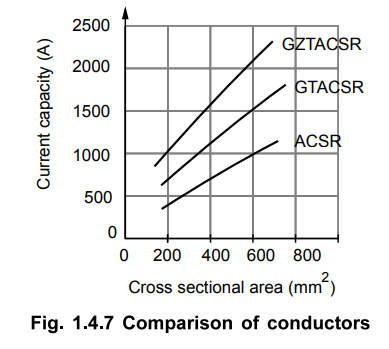
16. Bundled Conductors
For high voltage transmission more than
220 kV, two or more conductors are used per phase in close proximity but not
touching to each other. Such conductors are called bundled conductors. All such
conductors belonging to one phase are grouped together by a metallic structure
called spacers. The spacers are used to maintain constant distance between the
conductors throughout the length, avoiding touching of conductors amongest
themselves.
The Fig. 1.4.8 shows bundled conductors
with two conductors used per phase.
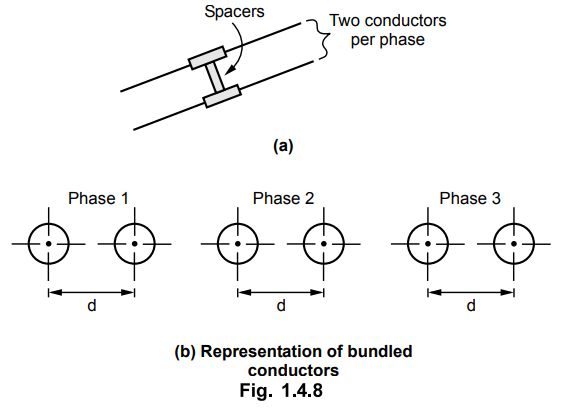
Each conducter joined by the spacer
belongs to the same phase. There are three such groups of conductors in single
circuit as shown in the Fig. 1.4.8 (b). In double circuit transmission, there
are six groups of conductors.
a. Advantages of Bundled Conductors
1. Reduced reactance of the line due to
increase in self geometric mean distance.
2. The maximum power transfer capability
of the line increases.
3. There is increase in the surge
impedance loading.
4. Increase in the capacitance of the
line.
5. Reduces the effect of corona and
radio interference.
6. Reduces voltage gradient at conductor
surface.
7. The current carrying capacity of the
line increases due to bundled conductors.
8. It increases effective surface area
exposed to air hence it has better and efficient cooling.
9. It has reduced influence of skin
effect.
The only limitation is that bundled
conductors experience greater wind loading than single conductors.
Review Questions
1. Explain the various types of line conductors used for
overhead transmission lines.
2. Write a note on : i) TACSR conductors ii) STACIR
conductors, iii) GTACSR conductors iv) GZTACSR conductors.
3. What are bundled conductors ? State its advantages.
Transmission and Distribution: Unit I: Transmission Line Parameters : Tag: : Hard Drawn Copper - Steel Cored - Cadmium - All Aluminium Alloy - Phosphor Bronze - Types of Line Conductors
Related Topics
Related Subjects
Transmission and Distribution
EE3401 TD 4th Semester EEE Dept | 2021 Regulation | 4th Semester EEE Dept 2021 Regulation
